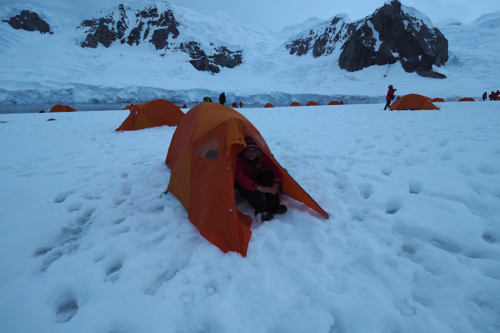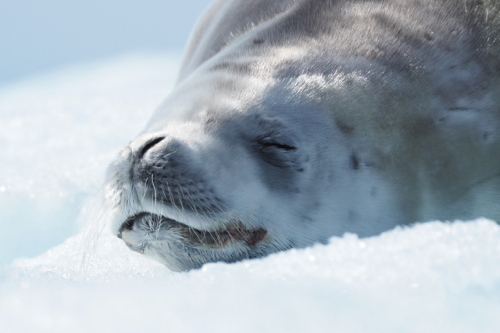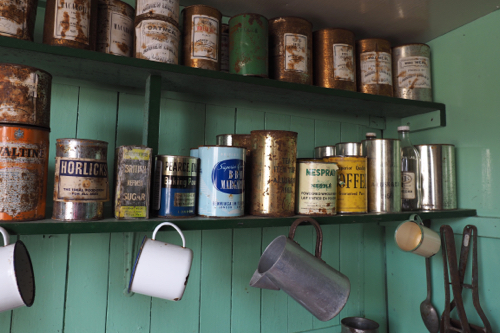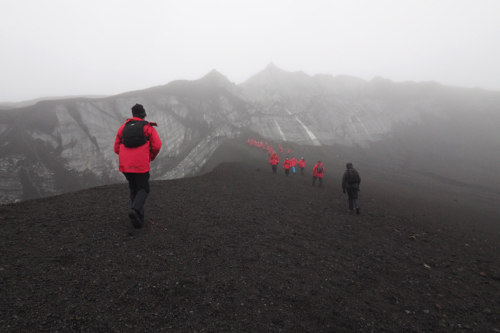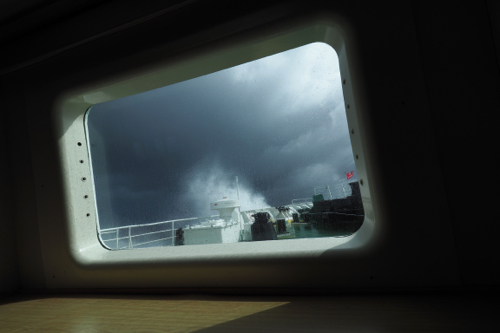February 1, 2018. Drake Passage to Antartica.
There wasn’t much to do today, as we were sailing south towards Antarctica.
We received a briefing on what birds we might encounter and another on ‘Zodiac operations aboard the G Expedition.’
There was a safety drill and we were then checked for ‘bio security’. We were then given our waterproof boots and G Adventures expedition polar jackets in the ‘Mud Room’.
The jackets were ‘free’ and bright red – we certainly wouldn’t get lost in the snow.
As Antarctica is a wilderness area, great care is taken to ensure that we tourists don’t contaminate it. Everything that you wear on leaving and boarding the ship is cleaned. We even had to dip our boots into a disinfectant wash.
I felt like a ram going through a sheep dip.
Normally we don’t do escorted or group tours but Antartica, like Egypt in 2012, was different. And like the Egypt trip we had booked this trip through Hampton Travel and Cruise.
They in turn had gone to G Adventures, who specialised in small group adventure travel.
G Adventure was formally known as Gap Adventures and was established in Toronto Canada in 1990.
Gap which stood for Great Adventure People was forced to change its name in 2018. This was after Gap Inc, the American clothing company, sued Gap Adventures for appropriating their name.
How litigious are the Yanks.
I don’t think it did the company or its founder, Bruce Poon Tip, any harm, as they currently employ 1,500 people and travel to 686 destinations in 134 countries.
They certainly do live up to their old name as Great Adventure People as the staff aboard the SS Expedition were fantastic.
As was the ship.
Formerly a car carrier, the SS Expedition has been converted into a fast, sturdy and well appointed cruise ship.
There are only 145 passengers, which meant that everyone had an opportunity to get off the ship and explore. There were also 69 crew so we were well looked after.
Our off-board adventures were done both on land and in the Zodiacs.
There were also the creature comforts, like a private ensuite in every cabin and excellent views of the rolling seas through a large panoramic port hole.
There were two bars and an excellent restaurant serving international cuisine.
I even tracked down where to get a half reasonable espresso.
G Adventures pride themselves on their environmental credentials, which was very important considering where we were going.
Antartica is the last wilderness.
It was also the last region on earth to be discovered and was unseen until 1820.
It is governed by the Antarctic Treaty System, which was ratified in 1961 and currently has 53 signatories. The treaty prohibits mineral mining, nuclear explosions or dumping of nuclear waste and military activities.
It does support science, as there are currently about 4,000 scientists conducting research into its delicate ecosystem.
The treaty is due to expire in 2048 and it will be interesting to see what takes its place. Especially considering the expansionist ambitions of countries like China and Russia.
February 2, 2018. South Shetland Islands, Antartica.
We made a very fast journey across the Drake Passage, which enabled us to get our first trip ashore much earlier than usual.
Our first stop was at the Aitcho Archipelago, South Shetland Islands, where we visited Barrientos and Cecilia Islands.
Both were very different experiences.
Barrientos Island was all about the penguins and there were thousands of them.
Their smell reached us on the ship, well before we arrived on the island.
There was also a group of moulting elephant seals lazing on the beach as we landed.
From there we caught another Zodiac to Cecilia Island. This one was all about the birds and also involved, for those who were willing, a short walk to the top of the island.
The walk was good as we had been on the ship for almost 48 hours and needed a bit of exercise.
The most we had done so far was walk from our cabin to the dining room.
For some of the passengers this was a very regular trip.
After our island excursion, the ship set sail again and we headed for Errera Channel in Antarctica proper.
We were now at 62° south and heading towards the Antarctic Peninsula.
February 3, 2018. Antartica.
The morning Zodiac adventure was to Danco Island in the Errera Channel.
Even though there were plenty of penguins, the views were the hero of this outing.
It was a slippery walk to the top of the island, but well worth it.
Apart from the ship and the attendant Zodiacs there were icebergs, islands and mountains in the background.
On several occasions it started to snow.
In the afternoon we sailed to Georges Point and had another trip in the Zodiacs. The point was named, like so many places in Antarctica, by people involved in their discovery.
Georges Lecointe was the second-in-command of the Belgian Antarctic Expedition of 1897 to 1899.
Here we came face-to-face with the brutal reality of life and death on the ice. We were witness to an attack of a Skuas on a penguin chic.
Penguins are not the brightest birds on the ice and the poor chic had no chance against the relentless predator.
Skuas are strong and aggressive birds living off carrion and the occasional ‘fresh’ penguin.
Later in the afternoon we sailed to Leith Cove In Paradise Bay. We were here for the evening as this was our night on the ice.
I have always held the belief that you really haven’t visited a place, unless you have slept there.
After dinner all those that were going ashore hopped into the Zodiacs and took the short ride to the ice island in Leith Cove.
We had been equipped with a tent, ground sheets and a sleeping bag, which we had to lug up the hill to the camp site.
Then we had to pitch our tent.
At this point I was wondering if sleeping in Antarctica was such a clever idea.
I hadn’t pitched a tent since I was in the scouts and I had certainly never done it on ice. We only hoped that it would stay up for the night.
There were 23 tents, each with two people, all arranged in a large circle. There were two portable toilets off to one side. I had made a pact with myself that I wouldn’t need to visit them during the night. The temperature was about -4° to -5°C and my sleeping bag was where I intended to stay for the duration.
A few younger campers joined Blaise, the resident ‘muso’, in a number of songs around a non-existent campfire.
We remained in our tent, in our sleeping bags, with our legs crossed.
February 4, 2018. Antartica.
We were woken at 5:40 am and had to quickly pack everything up. Then it was down to the Zodiacs to be taken back to the ship.
The rest of the morning was spent at Leith Cove. We then cruised through the Lemaire Channel and back again as our path to Pléneau Bay was blocked by icebergs.
In the afternoon our Zodiac ride was with Sergey Nesterov, the captain of the SS Expedition. The sky was blue, the sea calm and as one of the crew said; “This is just the sort of day that the captain likes to pull rank and take out a Zodiac.”
It was an experience with amazing icebergs and lots of seals – I think Sergey knew many of the seals personally.
He also had a typical Russian sense of humour which made it all the more enjoyable.
That evening we had an Antarctic Barbecue Dinner and like all good BBQs, it was outside.
There was flame grilled meat of all varieties as well as salads and hot vegetables.
We all sat at the stern of the ship, wrapped in our bright red G Adventures jackets, and ate as quickly as we could, before the hot food got cold.
An experience never to be forgotten – or repeated.
February 5, 2018. Antartica.
Breakfast onboard catered for everyone.
There were even jars of Vegemite for the Australians and Marmite for the Poms.
Which isn’t surprising as the Aussies, then the Brits, made up the largest groups.
The morning was spent in the Zodiacs, cruising around Paradise Harbour and then we visited Brown Station.
We were now on mainland Antarctica.
Brown Station was surprisingly not British, as you would expect, but Argentinian. Named after the ‘Father of the Argentine Navy’ Admiral William Brown (1777-1857). Brown was an Irish born Argentine Admiral who was creator and first admiral of the country’s maritime force.
Brown Station was established in 1951 and is one of 13 Argentinean research bases in Antarctica.
Many of the group made the difficult walk to the top of the hill overlooking Brown Station. The views were spectacular.
I think we were all dreading the descent, as the snow was deep and looking down, it seemed like a long way.
That problem was solved brilliantly by some of the crew who suggested that we didn’t walk down, but slid down.
It was an exhilarating trip, sliding on our bums, down the hillside.
In the afternoon we went to Port Lockroy to visit the British Antarctic Survey’s historic Base A and the Penguin Post Office.
Situated on Wince Island, Port Lockroy was named after Edouard Lockroy, a French politician and Vice President of the Chamber of Deputies. He assisted Jean-Baptiste Charcot in obtaining funding for the French Antarctic Expedition of 1904 to 1907.
Today Port Lockroy houses a museum, souvenir shop and the Penguin Post Office, the most southerly one in the world. We, like most of the passengers, sent post cards or letters home.
From there we went to Jougla Point, on Wiencke Island, just around the corner from Port Lockroy. There was a colony of Blue Eyed Shags and a collection of random whale bones that had been arranged into an almost complete skeleton.
The Polar Bear Bar on the SS Expedition was very popular, especially with the young North Americans, after dinner. They were ‘whooping’ to music that was at least a generation older than they were.
Blaise, who had entertained us on the island sleepover, performed hits from Simon and Garfunkel, Cat Stephens, Don McLean and even Leonard Cohen.
It was being lapped up by the ‘kids’ and they could sing the old stuff – word for word.
February 6, 2018. Antartica.
When referring to the weather, Alex, our English tour leader often said: “Antarctica has the last word”
For our final day on the continent we were greeted with foul conditions.
Forty knot winds, gusting to sixty knots, rain and low cloud.
Not ideal for launching and landing the Zodiacs.
Our planned afternoon trip to Hannah Point, Walker Bay and even plan B, to Elephant Point, were all cancelled.
We then opted for plan C and sailed to Deception Island, which is still regarded as an active volcano.
In the morning Thea accidentally slid down one of the external stairways on the ship and bruised her back.
The ship’s doctor suggested she rest up, so I went ashore alone.
The bay of Deception Island is a caldera, with a very narrow entrance. This means that it is considerably more protected than the surrounding sea.
The volcano last erupted in 1969 and then again in 1970 and has left a large crater.
That’s what we were on Deception Island to see.
It was foggy when we set out from the ship and got worse as we climbed up to the crater lip.
It was an eerie sight as the passengers appeared out of the mist, all in their red coats, walking along the crater’s edge.
We were warned that crossing back over the Drake Passage wasn’t going to be as easy as when we came six days ago.
The swell picked up over dinner and by the time we retired our beds became a moving target.
The ship actually provided wedges to put under the mattress. These were designed to stop you falling out of bed with the big swell.
After dinner there was a Black and White themed fancy dress. Some people made an effort, I wasn’t one of them.
We then went to the Polar Bear Bar where the Monkey Eating Eagles were playing.
This is a six piece band with five of the group staff members from the Philippines.
Apart from passengers, there were a lot of staff in the bar.
I had a feeling that this was their night off.
It was interesting to watch the band perform, with the ship rolling from side to side. But even funnier was seeing people trying to dance.
February 7, 2018. Crossing the Drake Passage from Antartica.
It was a rather turbulent night as we forged our way north into the Drake Passage.
We awoke to blue skies and rough seas. Half way through the morning the captain decided to shut the deck. This meant I couldn’t get my daily shot, over the bow of the ship, looking forward.
To keep us entertained there was a series of lectures. They covered topics like Antarctic animals and birds, history, geography, geology and photography.
Most of the staff seem to be an expert in one or more of these areas.
The SS Expedition is small, compared to some cruise ships, and in rough seas this presents unique challenges to passengers and staff.
Staying upright is one of them.
Showering, cleaning your teeth, getting your buffet meal, or just walking around, are all that much more difficult.
The only people who could handle us bobbing around like a cork in a bottle were the waiters. In classic waiter style, they could still carry a tray, loaded with dishes, all balanced in one hand.
By now the conditions had got much worse, there were seven metre waves and 60 knot winds.
On board the G Adventures staff are divided into three sections.
The ship’s crew, including engine room, navigation and deck hands. They look after how we travel.
The adventure and activities people who look after organising excursions, landings and lectures. They are in charge of what we do.
And finally the hotel staff, who run the accommodation, laundry, kitchen, restaurant, bar and accounts. They look after how we are housed, fed and make sure we pay for it all at the end.
And, as we found out, there is also a doctor who is there to look after your physical wellbeing.
At the start of the cruise we were told that the Drake Passage was going to be rough. The doctor suggested that we take sea sickness tablets.
The last time we had been in rough seas was back in the mid 70s’, crossing the English Chanel in a force nine storm. We were OK then but didn’t know how well we would travel now, so we took his advice and swallowed the pills.
We didn’t feel any sea sickness, only hallucinations.
On the return trip, across the Drake, we decided to leave the pills. This was the right choice as we were both fine, even though the crossing was far rougher.
February 8, 2018. The Drake Passage and Beagle Channel.
We were ‘weathering the storm’ all night and in the morning we were still not allowed up on deck.
At noon the captain headed the ship towards the north east. This resulted in two things, firstly the rolling almost disappeared and secondly we rounded Cape Horn, sailing from the Pacific to the Atlantic.
We were now headed towards the Beagle Channel and Ushuaia, with hopefully much calmer weather.
On our last evening, after a cruise de brief, we had a group dinner, then a few of us headed to the Polar Bear Bar for one more evening of ‘classic’ music.
We were now back in Ushuaia and would disembark after breakfast in the morning.
We had travelled 1,695 nautical miles and seen one of the most remote places on earth.
What an adventure.


